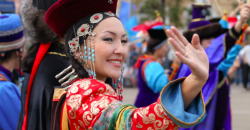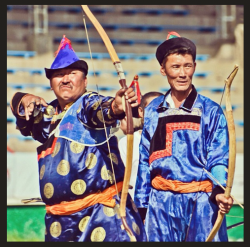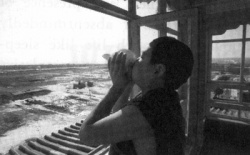The current state of Buddhism in ethnical Buryatia (the materials on sociological researches) by G.E. Manzanov
During the last twenty years general changes in religions situation being developed in Russia were reflected in regions too. But these processes have peculiar characteristics in each region as well as in ethnic Buryatia. This work is based on the results of three sociological surveys conducted under the project “Religions ideas of the Buryat people”.
In 1999 and in 2003 two sociological surveys were carried out in cooperation with the Faculty of Oriental Studies, BSU in ten rural districts of the Republic of Buryatia: Barguzinskiy, Kurumkanskiy, Dzhidinskiy, Zakamenskiy, Selenginskiy, Tunkinskiy, Zaigraevskkiy, Ivolginskiy, Kizhinginskiy, Horinsskiy and also in the capital of Buryatia – Ulan-Ude. Aginsk and Ust-Ordinsk Buryat autonomous districts. In 2011 the author conducted a joint sociological survey together with the Faculty of Humanitarian and Cultural Studies, ESSACA in fifteen rural districts: Bauntovskiy, Bichurskiy, Dzhidinskiy, Eravninskiy, Zakamenskiy, Zaigraevskkiy, Ivolginskiy, Kabanskiy, Kyahtinskiy, Kurumkanskiy, Pribaikalskiy, Severobaikalskiy, Selenginskiy, Tunkinskiy, Horinsskiy and also in Ulan-Ude, the capital of Buryatia.
According to the principal socio-demographic data the selective structure corresponds to the socio-demographic structure of the population on the above-mentioned subjects of Russian Federation at moment of the sociological surveys.
The estimation of cluster and quota extracts was carried on the basis of statistical data of Goskomstat (State Committee of Statistics) of Russian Federation and Goskomstat (State Committee of Statistics) of Republic of Buryatia. Cluster extracts were accepted according to the scheme of administrative districts and towns division of the Republic of Buryatia as well as Ust-Ordinskiy and Aginskiy Buryat districts.
According to the above-mentioned method a certain number of men and women were requested as to the attitude towards religion in 1999. Among them 619 in 1999, 613 in 2003, 700 in 2011 men and women of Buryat nationality at the age of 18 rep to 60 years and older, with both primary education and higher education, working in different spheres of professional activity – solders, students, unemployed and pensioners.
The sociological surveys with respect to the religion of Buryat population of the Republic of Buryatia, Aginsk and Ust-Ordinsk Buryat districts revealed that the most characteristic phenomenon of the quest is that a sharp growth believers was observed in the 90s of the XX th century. The questionnaires in 1999 and 2003 show that the religions situation is becoming more stable and a number of believers does not change practically. The questionnaire of 2011 showed that the number of believers increased considerably.
There are answers to the question: “What is your attitude towards religion?”
| 1999 | 2003 | 2011 | |
|---|---|---|---|
| I am a believer and observe religions rituals | 43,6% | 45,0% | 56,4% |
| I am believer but do not observe rituals | 31,0% | 24,6% | 24,7% |
| I am not sure | 4,9% | 5,4% | 3,1% |
| It's all the same to me | 3,6% | 4,4% | 3,3% |
| I am not a believer but I respect the feelings of believers |
14,2% | 15,2% | 9,2% |
| I think it's necessary to oppose religion | 0,3% | 0,5% | 0,9% |
| I hesitate, it’s difficult to answer | 2,4% | 4,9% | 2,4% |
The data in table 1 make one fall thinking over a lot of things. In the 70s-80s of the XX th century the scientists of the Institute for Mongolian, Buddhist and Tibetan Studies, Russian Academy of Sciences conducted different sociological surveys in respect to religion and atheism in the Republic of Buryatia, Aginsk and Ust-Ordinsk Buryat autonomous districts. The sociological surveys carried out among the Buryat population revealed an insignificant number of believers. The activity of religions organizations was not ob served practically. However the results of quests showed a considerable number of attendance of datsans and obo. Never the less the number of believers participating in religions rituals and holidays was reducing. In the half of the 80s of the XX th century it seemed that the objective social status of a person did not depend on church and religion. Development and consolidation of the socialist culture together with other factors of social reality changed spiritual life of a person. At the same time the materials of questionnaires showed a great percent of such evasive, uncertain answers to the questions like – “I do not know”, “I have no a definite opinion”. If could be explained both by the lack of knowledge of confessional dogmas, non-observance of ceremonies, indifferent altitude to them and by unwillingness and fear to give clear-cut answers about their altitude to religion. At that time it seemed that real crisis, collapse and disappearance of religion was taking place. If sociological surveys carried out by a group of scientific atheism IMBT SB RAS in the 1982 – 1987 s in the Republic of Buryatia showed 3-4 % of faithful believers 5-6 % of believers not observing religions rituals then in the 90s of the XX th century the situation strongly changed. How can it be explained? Probably because the Buryat population living in the spiritual vacuum caused by the crash of the political and ideological system founded on the communist ideals turned to religion hoping to acquire the meaning of life and moral guidance. Many respondents ideality their religious belonging with ethnic one. People stopped fearing and these appeared a real religious liberty a great role in the rebirth of, mass religiosity played a system
crisis of Russia’s economy, collapse of the former country, poverty and misery in which the greater part of the population fell. People began seeking support and consolation in religion. Not the least role was played by an efficient propaganda agitated by various religious organizations that once again confirms the fact how easy is to manipulate mass consciousness of the people in Russia.
These processes lie in the course of all Russia changes in religious situation. The outcome of the sociological studies of A-RCSPO(All-Russian center study of the public opinion), showed that a short period of less than ten years period a number of non-believes declassed approximately up to one third in the society. More over sociologist mark the rise of religious consciousness in Russia beginning already in 1988 when a thousand’s anniversary of Russia was celebrated as a national holiday. During the following four years a certain rise of believers in percent was observed and fixed. The highest growth was marked in 1993-1994s. But later as the studies record, a trend to recession began to show. It can be explained by the fact that for two showing in any society there is in own threshold. It is difficult to say whether it depends on national and ethnical composition of a state or on historical and specific laws of development of the definite country. This question should be studied in detail be studied be specialists in religious studies.[Mihailiuk, 2011 p.1-2]
This is the dynamics of religiosity in Russia during the last decade of the XX century and the early years of the XXIth century presented in the table two according to the results of sociological studies. The data show in percent those who believe in the existence of god as a personality or impersonal supernatural power as well as hesitating between religious faith and unbelief.
| 1991 | 1993 | 1995 | 1997 | 1999 | 2000 | 2001 | |
|---|---|---|---|---|---|---|---|
| A-RCSPO | 57 | 74 | |||||
| ISPS RAS | 66 | 68 | 70 | 71 | 73 | 72 | |
| ICSS RAS | 77 | 73,4 | 71,8 | 71,2 | 71 | ||
| Research project “Religion and values after the fall of communism” |
51 | 60 | 70 |
As one can see from the results of above-mentioned surveys obtained by different groups of researchers, although with some incoherence, a number of people more or less considering themselves as believers was increasing in the 1990s and by the end of the century formed from 70 up to 74 per cent of the adult population. Although during the last 3-4 years it has been outlined a certain stabilization at the level of religiosity, that probably illustrates a kind of exhaust of the reserves of its further growth. [Garadzha V.L, 2005, p. 326-327].
However, according to the laws of development of either phenomenon becomes more progressive. The sociological studies carried out in Russia a record that positive dynamics of the level of religiosity of the adult population of the country during the 2000s. At the same time a part of persons considering themselves believers reached 80,9 per cent un 2002 (records of he independent research center RОМIR)[How many believers / SOVA / c.7], 82 per cent in 2006 (data by A-RSCPO)[A-RSCPO/OWL, с.1] According to the data of Saint-Petersburg research Institute of complex studies correlation between believers and atheists was approximately 80 per cent to 18 per cent [[[Religion]] in figures and facts – Statistics.ru, c.2]. The data according to our study conform to the all Russian indexes(74,6 per cent in 1999, 69,6 per cent in 2003, 81,1 per cent - 2011) conform to the all Russian indexes.
The sociological studies showed that the dominant religious tradition among the Buryats was Buddhism.
- 1.In 1999, 2003, 2011, 61,2 per cent, 61,3 per cent and 70 per cent respectively identified themselves as the Buddhist believers. Here a stabilization of religious situation was observed.
- 2.Then there was a small decrease in the number of these who identified themselves as Shamanists, from 21,9 per cent in 1999 to 15,6 per cent in 2003, 18 per cent – 2011.
- 3.In 1999 0,4 per cent, 1,6 per cent in 2003 1,4 per cent in 2011 respectively identified themselves as Orthodox believers.
- 4.There was an insignificant increase in the numbers of followers of various Protestant denominations by 2003. It was 0,1 per cent in 1999, 1,3 per cent in 2003, 0,2 per cent - 2011 respectively.
- 5.The number of those who believed in their own God, but didn’t understand religion, was 1,8 per cent in 1999, 1,6 per cent in 2003 and 1,1 per cent in 2011.
- 6.Those who just believed in their own God were 3,9 percent in 1999, 3,1 per cent in 2003, and 2,3 per cent on 2011. There was a slight increase there.
- 7.A certain increase was observed in a significant number of respondents was not followers of any religion: from 10,6 percent in 1999 to 15,4 percent in 2003, 6,7 per cent in 2011 and then and considerable decrease was observed by 2011.
Further an interesting phenomenon of duality of religious was observed: 7,4 per cent in 1999, 9,5 per cent in 2003, 8 per cent in 2011 identified themselves both as Buddhist and Shamanists believers simultaneously.
According to the sociological studies which were carried be the office of the Chairman of the government of the Republican of Tuva in 2004 with participation of O.M. Homushku 58,5 per cent respondents of Tuva population in 2004 identified themselves as Buddhist, 6,7 per cent as Shamanists, 6,7 as Orthodox, 3,4 per cent as Protestants, 4,2 per cent as Christians, 6 per cent are as just believers for 9,6 per cent it was difficult to answer. [Homushku, 2005, p.190]
According to Mongol researcher Tseveniy Tsenbileg 85,8 per cent of respondents of Mongol population confirm themselves to the traditional Buddhist religion: 9,3 per cent to [[Wikipedia:Christianity|Christianity]], 1,3 per cent to Muslim, 3,5 per cent of the population believe in great Heaven or Shamanism, and only 3 per cent claimed themselves as convinced atheist[Tsentsebileg, 2002, p.112]
It may be explained that coincidence of the data obtained by our studies, Tuva and Mongol researches are conditioned by confessional peculiarities of Buddhism and by the number of common conditions of the way of life of these nations.
The results of the sociological research as already mentioned above showed that the predominant religious tradition is Buddhism, The survey results revealed that most of respondents think religion can be useful for moral up upbringing of people. The respondents can be divided into three groups according to their approach to the norms of Buddhist morality:
- The believers of varying degrees of religiosity who were aware that 10 black sins and 10 white virtues are the concepts of religious morality, and in the capacity of being such they are not at variance with the modern notions of happiness and good life.
- The vacillators who do not often see any difference between religious and non-religious morality. These people who don’t often see any difference between religious and non-religious morality. These people often put the non-religious and worldly matter into religious concepts of sin and virtue.
- The non-believes aware that these concepts of sin and virtue are the norms of religious morality, another being such are unauthoritative and unacceptable to them.
If we ask the question, what is in fact the actual influence of religious morality on the value orientations, we can definitely say that for most of those who believe in the norms of classical Buddhist morality, they definitely do play a certain role, but for the vast majority of modern Buryats the value orientations are determined by hard life of the perestroika era. Not the norm of Buddhist morality but the post-socialist existence determine their actual understandings of the meaning of human life, the substance of happiness and the practical ways to achieve it.
The effaced indeterminate concepts, in which there is no definite boundary between religious for these who have not developed a holistic worldview This group of respondents assumed that religion could help grooming good people, honest, kind, well behaved, and who do not violate the norms of human social behavior.
Usually, the believers and nonbelievers of the 10 commandments of sins and virtues remember only those which relate to the simple rules of human social behavior: immorally to kill steal, get drunk, cause harm to people be blasphemy, slander, lie, etc. These moral concepts on submission of man are intended to regulate human relations. Buddhism uses these norms to create and protect its authority, timelessly propagates them in its own interpretation by all forms of ideological influence direct oral and written didactics, by means of artistic expression in parables, proverbs, instructive stories, legends, tales of animals for religious education of children in the family and by means of fine art. The whole theory of religious education is help up by the following ideas, which the Buddhist church aspires to transform into personal conviction as well as to introduce in the value orientation of people:
- Everyday existence is painful because of is transience, unpredictability, instability and therefore per se it has no value and it is useful only for accumulating virtues that will be enable a person to break off the chain of forced rebirth in “sansara”.
- Common man is helpless in this painful world, his only salvation and refuge in his selfless faith in “three jewels”: the Buddha, dharma and sangha. Only they can save person in future rebirth, a man should entrust his body, heart, word only to them.
- A person must realize his non-entity before the sanctity of these treasures caring for prosperity, welfare, religion, church and clergy are highest civic duty and moral ideal of man.
- People are attracted to Buddhist and more subtle philosophical evidences of senselessness in addition in to illusory nature of phenomenal existence. The moral teaching is given out from the standpoint of universal norms and concepts this aspects is also present in popular writings for mass propaganda of Buddhism.
On the basis of the total volume of sociological research in general, one may conclude that they predominating religion among Buryats is Buddhism. The Buddhist religions concepts of worldly existence and destiny of man serve for a part of the Buryat population as a feasible motive that determine life’s planes as well as day-to-day productive and social activities. That’s why the buck of respondents gave positive evaluation enable them to consider their life generally well, despite various hardships. The following were responses to the question “With what frame of mind do you look into the future?”
Table 3| 1999 | 2003 | 2011 | |
|---|---|---|---|
| With hope and optimism | 40,2% | 48,8% | 60,1% |
| I take it easy, without any particular hopes of illusions | 39,1% | 31,7% | 27,7% |
| With anxiety and uncertainly | 13,4% | 9,5% | 4,5% |
| With fear and despair | 1,5% | 1,5% | 2,4% |
| I find it difficult to answer | 5,8% | 8,7% | 5,4% |
However as the conversations show, many respondents agree to the Buddhist dogma that considers suffering as eternal, integral and only real essence of earthy existence and agree to the Buddhist of karma. Many people consider that only the faithful Buddhist are the Bearers of high morality. The majority of the respondents considered that the worship of Buddha, lama and offerings in temples as prerequisites for positive moral qualities of human being all the above-mentioned factors corroborate the decisive importance of social existence for the nature of moral directives and value orientations. All this is probably the major outcome of the impact of the difficult post-soviet reality in the minds of the contemporary Buryats.
The sociological studies conducted in 1999, 2003 and in 2011 showed that the most stable component of the religious complex is house hold religious rites.
Currently, the Buryat population actively participate in datsans, religious rites of common ulus and family. To the question: “Did you have to participate in religious ceremonies during the past 12 month?” the answers were as follows:
| 1999 | 2003 | 2011 | |
|---|---|---|---|
| Yes | 66,7% | 64,1% | 69,8% |
| No | 29,6% | 30,7% | 24,4% |
| I find it difficult to answer | 3,7% | 5,2% | 5,9% |
The most popular ritual is still obo-tahilga. In 1999 – 41,5 per cent, in 2003 – 41,2 per cent, in 2011 – 40,9 per cent of respondents took part in this ritual. Assimilate by Buddhism this pre-lamaist cult is a ritual of worshiping spirits-protectors of a definite locality.
In 1999 - 37,7 per cent, in 2003 – 39,1 per cent, in 2011 – 40,7 per cent of respondents took part in the ritual as serzhem. Nowadays serzhem is one of most popular rituals. People perform the ritual of serzhem in many cases. The form of performance of this ritual is Buddhist-shamanist, so the performers of the ritual may be both shamanists and lamas.
Rather a considerable number of respondents took a part in the ritual of sahyuusan – in 1999 - 29,2 percent, in 2003 – 21,3 percent, in 2011 – 34,2 percent. This shaman cult of ongons, family-tribal and personal sahyuusans(patrons) in many cases from the rank of srunina, chouzhins, ordokshist herek - by Buddhist household praying in honour of Sahyuusans. One of the most stable life rituals id khii-morin-an air winged horse. In 1999 – 22 per cent, in 2003 – 22,8 per cent, in 2011 – 43,8 per cent of respondents took part in the ritual as khii-morin. When a person suffers high sleepiness, or is on lour spirits, complain of illness and frequent failures lama usually says that a person has not got sulde and his life strength has weakened. Nowadays the ritual of khii-morin is performer by hanging out of piece of material with a picture of “horse of happiness”, where a person’s nabe(or of the hole family) is written on their behalf. Khii-morin is usually Hung on the trees growing near datsans in the peace performing obo and near the healing springs.
The existence revival of the household rituals of natural economic and life cycles is explained by the fact that they are associated with the requirement of daily life.
These phenomena take place in the process of actualization of Buddhist education received in childhood, when the habits of religious behavior are transformed into more or less regular observance of rituals, which in turn, contributes to the emotional setting for the restoration of religious beliefs that often have no holistic worldview.
The process of a man’s approach to religion usually starts from emotional and psychological pre requites for inclusion into stereotypes of traditional behavior, which often leads to the need to participate in religious rite has emotional and aesthetic aspects of influence which to some extent gives vent to physiological needs of relieving tension, consolation and communication on the basis of positive effect. Therefore, the cult practice in with its social function, traditional collectivism of ethnic community becomes of powerful tool of preservation and actualization of the of the Buddhist ideology.
Literature
- 1.Mihailyuk V.I. Religious orientation of the population sociological studies. http://www.synergia.itn.ru/kerigma/katehiz/stat/rel-orn.htm
- 3.How many believers / Religion in secular society/ SOVA – information-analytical center. http://www.sova-center.ru/religion/discussions/how-many-about/ 08.05.2011
- 4.A-RSCPO presented the results of the regular studies in their attitude of religion / SOVA – information-analytical center. http://www.sova-center.ru/religion/discussions/how-many/ 2006/09/d9011/
- 5.Religion figures and facts – Statistics.http://statistika.ru/naselen/2007/12/05/naselen9686.html.
- 6.Homushku O.M. Religion in the culture of Sayan-Altai peoples. – M: Publiship House RASS, 2005.
- 7.Tseveniy Tsetsenbileg. The problems of modernization of Mongol society. – Ulaanbaatar,
Source
Author: G.E. Manzanov
buddhismandaustralia.com






